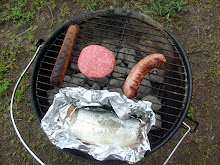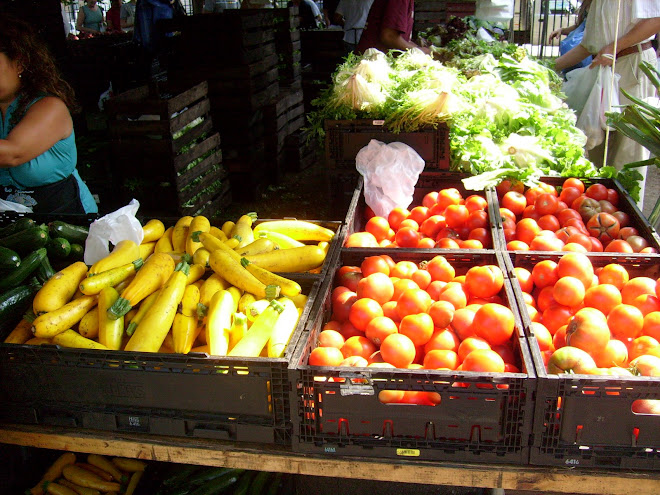My treasures from foraging in Prospect Park
Ready to Forage!
Foraging with 'Wild Man'. It's something that has interested me since I first caught wind of it a few years back. Steve Brill, botanist and self-proclaimed forager, lives in Westchester and offers foraging exhibitions in local parks and wildlife areas in New York, Connecticut, and New Jersey. It is his business, but clearly also his passion. His vast knowledge of wild plants and sense of humor combined makes the tour not just any old walk in the park. On these outings, he identifies and gathers wild and native edibles that are found growing in our public spaces and offers advice on their uses and recipes, as well.
Such a beautiful day in Brooklyn!
For those of you who know that I live in New York City, this may sound like a joke--what would I forage to eat in NYC? Rocks? Birdseed? Old bagels in trash cans? Probably, but all it took was a quick call, a desire to spend the day in the one of our many urban green spaces like Central Park or Prospect Park, and $15 to the Wild Man (and an ambitious foraging buddy--thanks, Sarah) and I was foraging real edibles!!
Flowers are popping up everywhere!
I was shocked and amazed at how many things are already growing in the chilly northeast in early March. Some forage-able items were year-round like things that came from trees, but we managed to find a good amount of tiny, tender green sprouted leaves of various sorts and even spotted some tiny early enoki mushrooms.
Witch Hazel in it's purest form!
I love the contrast of Brooklyn buildings in the background here.
As we entered the Prospect Park, immediately someone in the group spotted green! We had come upon chickweed popping up all over the hillside right at the Grand Army Plaza entrance! It was freshly sprouted and tiny, but it was there! Then we came upon such a beautiful tree-like shrub unlike any I had grown up with. Despite being somewhat un-usable to the amateur forager, this witch hazel tree was still such a sight to behold amidst the still bare branches that it was nestled among.
The Wild Man himself
As we hiked and noticed plants and green sprout-y things, the Wild Man would identify edibles and assist in finding enough for everyone in the group to take home, when appropriate. It is worth noting that in plants that need their greens to regenerate, he would identify and discuss the plant, then instruct us not to take them for the sake of their survival in the park. He also entertained the group with plant-inspired stories and played his instrument, the "Brillophone", which was apparently invented by his father and involves air moving through a round mouth and clapping cupped hands--you have to see it to believe it. At lunchtime, we stopped to munch on whatever snacks we brought along. He was generous and shared some delicious sour rye bread that he made by harvesting wild yeast from the air and fruit leather that was so delicious that he made from oliveberries in Central Park. Yep, this guy was a character, alright. All in all, it made for a fun and satisfying day. Check out Wild Man Steve Brill's website for booking a foraging day, ordering books, or just checking out his delicious vegan recipes featuring foraged ingredients. http://www.wildmanstevebrill.com/


Northern Bayberry Leaves
Here are some other things we foraged and their uses:
Gingko nuts: about the size of acorns and can be roasted and eaten. They had an interesting flavor to rice or salad that tastes like a combination of green peas and Limburger cheese. Whoa, right?
Daylilies: have a flat shoot and are light green in color. Has a string bean taste with a mild onion bite. The tubers are also edible and taste radish-y. Both are great in stir-fries.
Garlic Mustard Greens: beautiful tiny leaves that look like heart-shaped mint leaves. They have a fresh garlic bite and the wild man recommends making pesto with them.
Kentucky Coffee Tree: huge green pods the have big beans in them. The recommended usage is roasting the beans and grinding them. Then, making a hot chocolate-type beverage with soy milk, carob chips, cocoa powder, soy lecithin, stevia, and a bit of orange extract.
Common Spice Bush: a large bush that has fragrant twigs that are reminiscent of allspice. Can be used in sweet or savory dishes.
Black Birch: a tree with wintergreen flavored twigs that offer a mild aspirin-like effect. Apparently, aspirin is derived from elements from this tree. The twigs make a nice minty tea, but also are the best for teething babies since they have a pain killer effect.
Northern Bayberry: leaves of this tree were dried, but still hanging on. They are the native, wild version of bay leaves.
Mugwort: powerful Chinese herb
Common Thistle: cook in soup/smells like parsley
Sassafrass: the tree that is used in the making of natural root beer, has medicinal uses, as well
Garlic Chives were everywhere!
Wild Salmon and Asparagus with Garlic Chives
4 6-8 oz wild salmon fillets, rinsed and patted dry
2 T white wine vinegar
1/2 t minced garlic
1 T Dijon mustard
1 T extra-virgin olive oil
1/4 t sea salt
1/4 t freshly ground black pepper
1 bundle thin asparagus stalks, trimmed and/or peeled at the bottom
1/4-1/2 cup snipped garlic chives (regular chives work if you can't find them!)
1 lemon, cut into wedges
Place fillets in a shallow bowl. Mix vinegar, garlic, Dijon, oil, salt, and pepper in a small bowl and reserve half of the mixture. Pour other half over fish. Cover and chill for 30 minutes to 6 hours.
Preheat oven to broil and line a broiling pan with foil to prevent a mess. Toss asparagus with reserved marinade and transfer to lined broiling pan. Remove fish from marinade and pat fillets dry. Arrange on lined broiling pan and sprinkle generously with snipped garlic chives.
Broil 8-10 minutes or until fish is just done in the center. This is approximate and depends on the thickness of your fillets and also on your oven. Serve immediately with lemon wedges.
2 T white wine vinegar
1/2 t minced garlic
1 T Dijon mustard
1 T extra-virgin olive oil
1/4 t sea salt
1/4 t freshly ground black pepper
1 bundle thin asparagus stalks, trimmed and/or peeled at the bottom
1/4-1/2 cup snipped garlic chives (regular chives work if you can't find them!)
1 lemon, cut into wedges
Place fillets in a shallow bowl. Mix vinegar, garlic, Dijon, oil, salt, and pepper in a small bowl and reserve half of the mixture. Pour other half over fish. Cover and chill for 30 minutes to 6 hours.
Preheat oven to broil and line a broiling pan with foil to prevent a mess. Toss asparagus with reserved marinade and transfer to lined broiling pan. Remove fish from marinade and pat fillets dry. Arrange on lined broiling pan and sprinkle generously with snipped garlic chives.
Broil 8-10 minutes or until fish is just done in the center. This is approximate and depends on the thickness of your fillets and also on your oven. Serve immediately with lemon wedges.














No comments:
Post a Comment